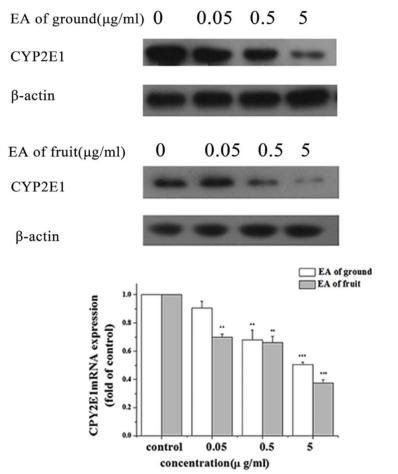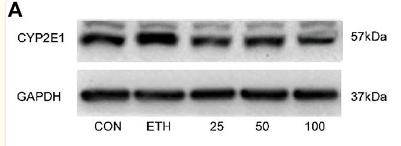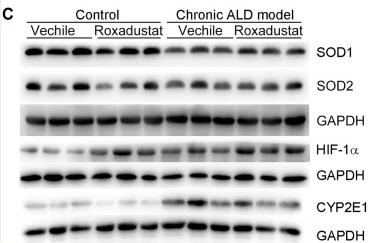Cytochrome P450 2E1 Antibody - #DF6883
| Product: | Cytochrome P450 2E1 Antibody |
| Catalog: | DF6883 |
| Description: | Rabbit polyclonal antibody to Cytochrome P450 2E1 |
| Application: | WB IHC IF/ICC |
| Cited expt.: | WB, IHC |
| Reactivity: | Human, Mouse, Rat |
| Prediction: | Pig, Bovine, Horse, Rabbit, Dog |
| Mol.Wt.: | 57kDa; 57kD(Calculated). |
| Uniprot: | P05181 |
| RRID: | AB_2838842 |
Product Info
*The optimal dilutions should be determined by the end user. For optimal experimental results, antibody reuse is not recommended.
*Tips:
WB: For western blot detection of denatured protein samples. IHC: For immunohistochemical detection of paraffin sections (IHC-p) or frozen sections (IHC-f) of tissue samples. IF/ICC: For immunofluorescence detection of cell samples. ELISA(peptide): For ELISA detection of antigenic peptide.
Cite Format: Affinity Biosciences Cat# DF6883, RRID:AB_2838842.
Fold/Unfold
4-nitrophenol 2-hydroxylase; CP2E1_HUMAN; CPE1; CYP2E; Cyp2e1; CYPIIE1; Cytochrome P450 2E1; Cytochrome P450 isozyme 3A; Cytochrome P450 LM3A; Cytochrome P450, family 2, subfamily e, polypeptide 1; cytochrome P450, subfamily IIE (ethanol-inducible), polypeptide 1; Cytochrome P450, subfamily IIE; Cytochrome P450-ALC; Cytochrome P450-J; Cytochrome P450RLM6; EC 1.14.13.-; EC 1.14.13.n7; Ethanol-inducible P450; Flavoprotein-linked monooxygenase; MGC133529; Microsomal monooxygenase; OTTHUMP00000020813; OTTHUMP00000046571; P450 ALC; P450-J; P450C2E; P450J; P450RLM6; Xenobiotic monooxygenase;
Immunogens
A synthesized peptide derived from human Cytochrome P450 2E1, corresponding to a region within the internal amino acids.
- P05181 CP2E1_HUMAN:
- Protein BLAST With
- NCBI/
- ExPASy/
- Uniprot
MSALGVTVALLVWAAFLLLVSMWRQVHSSWNLPPGPFPLPIIGNLFQLELKNIPKSFTRLAQRFGPVFTLYVGSQRMVVMHGYKAVKEALLDYKDEFSGRGDLPAFHAHRDRGIIFNNGPTWKDIRRFSLTTLRNYGMGKQGNESRIQREAHFLLEALRKTQGQPFDPTFLIGCAPCNVIADILFRKHFDYNDEKFLRLMYLFNENFHLLSTPWLQLYNNFPSFLHYLPGSHRKVIKNVAEVKEYVSERVKEHHQSLDPNCPRDLTDCLLVEMEKEKHSAERLYTMDGITVTVADLFFAGTETTSTTLRYGLLILMKYPEIEEKLHEEIDRVIGPSRIPAIKDRQEMPYMDAVVHEIQRFITLVPSNLPHEATRDTIFRGYLIPKGTVVVPTLDSVLYDNQEFPDPEKFKPEHFLNENGKFKYSDYFKPFSTGKRVCAGEGLARMELFLLLCAILQHFNLKPLVDPKDIDLSPIHIGFGCIPPRYKLCVIPRS
Predictions
Score>80(red) has high confidence and is suggested to be used for WB detection. *The prediction model is mainly based on the alignment of immunogen sequences, the results are for reference only, not as the basis of quality assurance.
High(score>80) Medium(80>score>50) Low(score<50) No confidence
Research Backgrounds
A cytochrome P450 monooxygenase involved in the metabolism of fatty acids. Mechanistically, uses molecular oxygen inserting one oxygen atom into a substrate, and reducing the second into a water molecule, with two electrons provided by NADPH via cytochrome P450 reductase (NADPH--hemoprotein reductase). Catalyzes the hydroxylation of carbon-hydrogen bonds. Hydroxylates fatty acids specifically at the omega-1 position displaying the highest catalytic activity for saturated fatty acids. May be involved in the oxidative metabolism of xenobiotics (Probable).
Endoplasmic reticulum membrane>Peripheral membrane protein. Microsome membrane>Peripheral membrane protein. Mitochondrion inner membrane>Peripheral membrane protein.
Note: Post-translationally targeted to mitochondria. TOMM70 is required for the translocation across the mitochondrial outer membrane. After translocation into the matrix, associates with the inner membrane as a membrane extrinsic protein.
Belongs to the cytochrome P450 family.
Research Fields
· Human Diseases > Endocrine and metabolic diseases > Non-alcoholic fatty liver disease (NAFLD).
· Human Diseases > Cancers: Overview > Chemical carcinogenesis.
· Metabolism > Lipid metabolism > Steroid hormone biosynthesis.
· Metabolism > Lipid metabolism > Arachidonic acid metabolism.
· Metabolism > Lipid metabolism > Linoleic acid metabolism.
· Metabolism > Xenobiotics biodegradation and metabolism > Metabolism of xenobiotics by cytochrome P450.
· Metabolism > Xenobiotics biodegradation and metabolism > Drug metabolism - cytochrome P450.
· Metabolism > Xenobiotics biodegradation and metabolism > Drug metabolism - other enzymes.
· Metabolism > Global and overview maps > Metabolic pathways.
References
Application: WB Species: Mouse Sample:
Application: WB Species: mouse Sample: liver
Application: IHC Species: Mice Sample: liver tissues
Application: WB Species: Human Sample: LO2 cells
Application: WB Species: mouse Sample: liver
Restrictive clause
Affinity Biosciences tests all products strictly. Citations are provided as a resource for additional applications that have not been validated by Affinity Biosciences. Please choose the appropriate format for each application and consult Materials and Methods sections for additional details about the use of any product in these publications.
For Research Use Only.
Not for use in diagnostic or therapeutic procedures. Not for resale. Not for distribution without written consent. Affinity Biosciences will not be held responsible for patent infringement or other violations that may occur with the use of our products. Affinity Biosciences, Affinity Biosciences Logo and all other trademarks are the property of Affinity Biosciences LTD.










